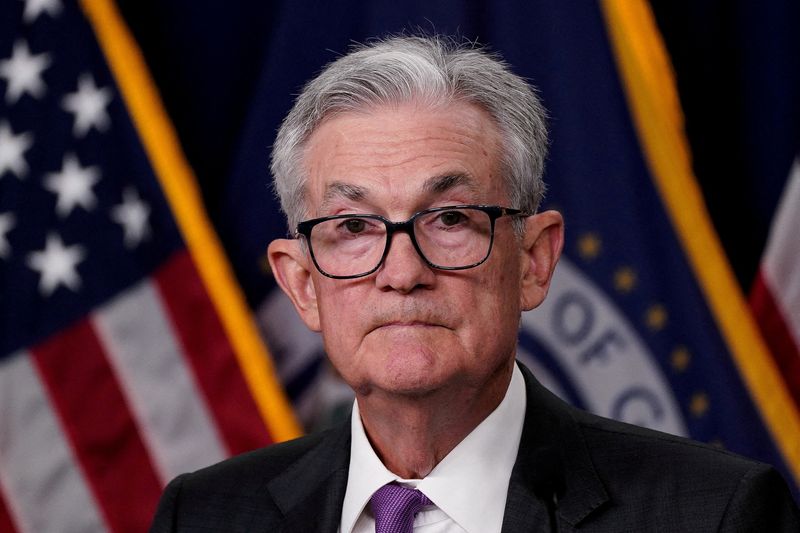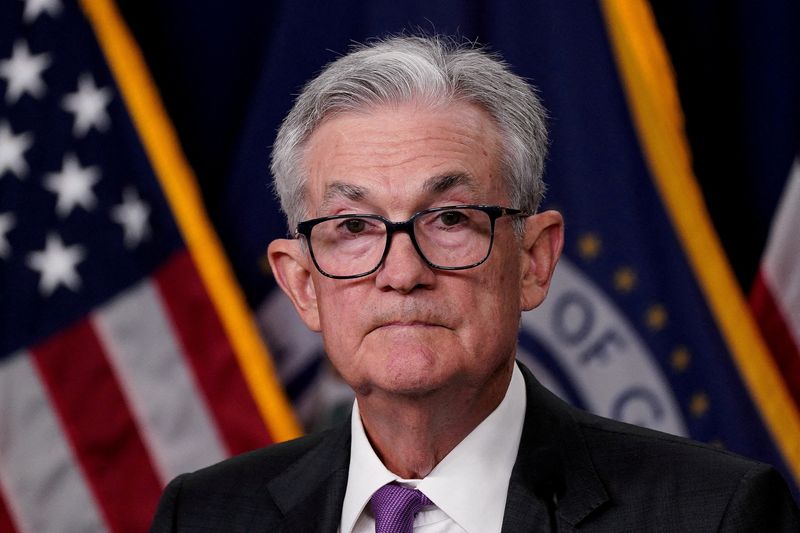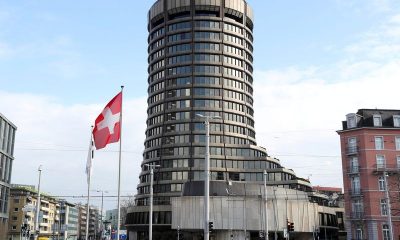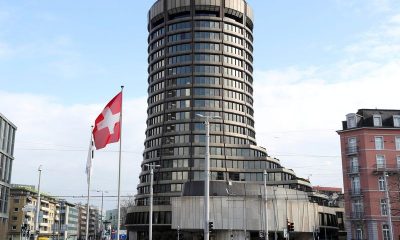Economy
Rate hike chances rise after remarks by Fed’s Powell


© Reuters. FILE PHOTO: U.S. Federal Reserve Chair Jerome Powell attends a news conference in Washington, U.S., July 26, 2023. REUTERS/Elizabeth Frantz/File Photo
By Gertrude Chavez-Dreyfuss and Dan Burns
NEW YORK (Reuters) – Interest rate futures tied to the Federal Reserve’s policy rate on Friday priced in a more than even chance of tightening at either the November or December policy meetings after Chair Jerome Powell struck what market participants perceived to be a moderately hawkish tone.
The Fed though is widely expected to hold rates steady at a range of 5.25% to 5.50% at the Sept. 19-20 meeting.
Powell said on Friday Fed policymakers would “proceed carefully as we decide whether to tighten further,” but also made clear that the central bank has not yet concluded that its benchmark interest rate is high enough to be sure that inflation returns to the 2% target.
He delivered the remarks at the annual economic symposium hosted by the Kansas City Fed held in Jackson Hole, Wyoming.
“It was clear from the outset that the chair was not going to offer the doves any seeds of hope,” said Ellis Phifer, managing director, fixed income capital markets at Raymond James in Memphis, Tennessee.
“The economy is running faster than the Fed expected it would, along with the labor market, but inflation is cooling and is expected to do so. The Fed’s stance that higher for longer remains intact.”
In choppy trading, Refinitiv’s FedWatch on Friday showed a roughly 53% chance of an interest rate increase at the Oct. 31-Nov. 1 meeting. For the Dec. 12-13 meeting, the odds were about 52%.
At the CME, its own FedWatch tool showed a slightly higher probability of a hike than Refinitiv’s: roughly 57% for the November meeting and 55% in December. A week ago, the rate increase chances were at 36.1% and 31.7%, respectively.
Interest rate futures tied to the Fed policy rate have shifted notably over the last few weeks.
A recent backup in Treasury yields may help buttress the Fed’s efforts to weaken demand and slow the momentum of an economy that has so far mostly shaken off the most aggressive monetary tightening in more than a generation.
The Fed has jacked up its policy rate from near zero in March 2022 to the current range of 5.25% to 5.50%, but the unemployment rate remains at a historically low 3.5% and overall economic growth has defied expectations that it would falter.
Alongside the rise in bond yields, rate futures have notably repriced as well. While expectations remain firmly in place for the Fed to stand pat next month, the shift in rate futures now puts an increase at either of the final two meetings of the year squarely in play.
Economy
Russian central bank says it needs months to make sure CPI falling before rate cuts -RBC


© Reuters. Russian Central Bank Governor Elvira Nabiullina attends a news conference in Moscow, Russia June 14, 2019. REUTERS/Shamil Zhumatov/File Photo
MOSCOW (Reuters) – Russia’s central bank will need two to three months to make sure that inflation is steadily declining before taking any decision on interest rate cuts, the bank’s governor Elvira Nabiullina told RBC media on Sunday.
The central bank raised its key interest rate by 100 basis points to 16% earlier in December, hiking for the fifth consecutive meeting in response to stubborn inflation, and suggested that its tightening cycle was nearly over.
Nabiullina said it was not yet clear when exactly the regulator would start cutting rates, however.
“We really need to make sure that inflation is steadily decreasing, that these are not one-off factors that can affect the rate of price growth in a particular month,” she said.
Nabiullina said the bank was taking into account a wide range of indicators but primarily those that “characterize the stability of inflation”.
“This will take two or three months or more – it depends on how much the wide range of indicators that characterize sustainable inflation declines,” she said.
The bank will next convene to set its benchmark rate on Feb. 16.
The governor also said the bank should have started monetary policy tightening earlier than in July, when it embarked on the rate-hiking cycle.
Economy
China identifies second set of projects in $140 billion spending plan


© Reuters. FILE PHOTO: Workers walk past an under-construction area with completed office towers in the background, in Shenzhen’s Qianhai new district, Guangdong province, China August 25, 2023. REUTERS/David Kirton/File Photo
SHANGHAI (Reuters) – China’s top planning body said on Saturday it had identified a second batch of public investment projects, including flood control and disaster relief programmes, under a bond issuance and investment plan announced in October to boost the economy.
With the latest tranche, China has now earmarked more than 800 billion yuan of its 1 trillion yuan ($140 billion) in additional government bond issuance in the fourth quarter, as it focuses on fiscal steps to shore up the flagging economy.
The National Development and Reform Commission (NDRC) said in a statement on Saturday it had identified 9,600 projects with planned investment of more than 560 billion yuan.
China’s economy, the world’s second largest, is struggling to regain its footing post-COVID-19 as policymakers grapple with tepid consumer demand, weak exports, falling foreign investment and a deepening real estate crisis.
The 1 trillion yuan in additional bond issuance will widen China’s 2023 budget deficit ratio to around 3.8 percent from 3 percent, the state-run Xinhua news agency has said.
“Construction of the projects will improve China’s flood control system, emergency response mechanism and disaster relief capabilities, and better protect people’s lives and property, so it is very significant,” the NDRC said.
The agency said it will coordinate with other government bodies to make sure that funds are allocated speedily for investment and that high standards of quality are maintained in project construction.
($1 = 7.1315 renminbi)
Economy
Russian central bank says it needs months to make sure CPI falling before rate cuts -RBC


© Reuters. Russian Central Bank Governor Elvira Nabiullina attends a news conference in Moscow, Russia June 14, 2019. REUTERS/Shamil Zhumatov/File Photo
MOSCOW (Reuters) – Russia’s central bank will need two to three months to make sure that inflation is steadily declining before taking any decision on interest rate cuts, the bank’s governor Elvira Nabiullina told RBC media on Sunday.
The central bank raised its key interest rate by 100 basis points to 16% earlier in December, hiking for the fifth consecutive meeting in response to stubborn inflation, and suggested that its tightening cycle was nearly over.
Nabiullina said it was not yet clear when exactly the regulator would start cutting rates, however.
“We really need to make sure that inflation is steadily decreasing, that these are not one-off factors that can affect the rate of price growth in a particular month,” she said.
Nabiullina said the bank was taking into account a wide range of indicators but primarily those that “characterize the stability of inflation”.
“This will take two or three months or more – it depends on how much the wide range of indicators that characterize sustainable inflation declines,” she said.
The bank will next convene to set its benchmark rate on Feb. 16.
The governor also said the bank should have started monetary policy tightening earlier than in July, when it embarked on the rate-hiking cycle.

 Forex3 years ago
Forex3 years agoForex Today: the dollar is gaining strength amid gloomy sentiment at the start of the Fed’s week

 Forex3 years ago
Forex3 years agoUnbiased review of Pocket Option broker

 Forex3 years ago
Forex3 years agoDollar to pound sterling exchange rate today: Pound plummeted to its lowest since 1985

 Forex3 years ago
Forex3 years agoHow is the Australian dollar doing today?

 Cryptocurrency3 years ago
Cryptocurrency3 years agoWhat happened in the crypto market – current events today

 World3 years ago
World3 years agoWhy are modern video games an art form?

 Commodities3 years ago
Commodities3 years agoCopper continues to fall in price on expectations of lower demand in China

 Economy3 years ago
Economy3 years agoCrude oil tankers double in price due to EU anti-Russian sanctions

























